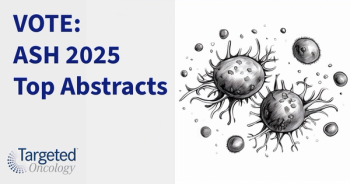
TIVO-3 Trial End Point Q-TWiST Increased With Tivozanib in RCC
The VEGF tyrosine kinase inhibitor tivozanib hydrochloride demonstrated a significantly increased quality-adjusted time without symptoms of disease and toxicity as third- or fourth-line therapy in patients with metastatic renal cell carcinoma compared with sorafenib in the phase 3 TIVO-3 trial.
The VEGF tyrosine kinase inhibitor tivozanib hydrochloride demonstrated a significantly increased quality-adjusted time without symptoms of disease and toxicity (Q-TWiST) as third- or fourth-line therapy in patients with metastatic renal cell carcinoma (RCC) compared with sorafenib (Nexavar) in the phase 3 TIVO-3 trial (NCT02627963).1
“The difference in Q-TWiST in TIVO-3 was primarily driven by benefits of tivozanib in TWiST, partially offset by superiority of sorafenib in time after progression/relapse
[REL],” the investigators wrote in their abstract for the 2021 American Society of Clinical Oncology (ASCO) Genitourinary Cancer Symposium.
To quantify the net health benefits of tivozanib, the investigators applied Q-TWiST methods because of the similar survival of the 2 agents reported previously.2
Investigators calculated mean Q-TWiST by applying utility coefficients of 0.5, 1.0, and 0.5 to the 36-month restricted mean health states of time with toxicity, time without symptoms and toxicity, and REL, respectively.1 The relative Q-TWiST gain was defined as the mean absolute Q-TWiST difference divided by the sorafenib mean overall survival (OS).
The mean Q-TWiST was 15.04 months for tivozanib versus 12.78 months for sorafenib (P =.0493). The relative gain for tivozanib was 11.2%. With more follow-up, there were better Q-TWiST means. Q-TWiST at 36 months of follow-up, which was the primary end point of this analysis, the mean was 2.25 (95% CI, 0.01-4.51) in favor of tivozanib. Mean TWiST was significantly longer for tivozanib versus sorafenib (10.30 months vs 5.35 months; TABLE).
For this multicenter, randomized, controlled, open-label trial, 350 patients were split evenly between the 2 drugs and stratified by International Metastatic Renal Cell Carcinoma Database Consortium risk category and type of previous therapy.2 These patients had to progress on 2 or 3 prior systemic regimens, at least 1 of which had to be a VEGFR tyrosine kinase inhibitor other than sorafenib or tivozanib.
Patients either received 1.5 mg of tivozanib mg orally once a day on 4-week cycles or sorafenib at 400 mg orally twice a day continuously. The primary end point was progression-free survival (PFS) by independent review in the intention-to-treat population.
In the previous report of TIVO-3, tivozanib increased PFS compared with sorafenib but did not show a difference in OS. The PFS difference at a 19-month median follow-up was significant between tivozanib and sorafenib at 5.6 and 3.9 months, respectively (HR, 0.73; 95% CI, 0.56-0.94; P =.016).
The most common grade 3/4 treatment-related adverse events (TRAEs) in the originally published data were hypertension in 20% of patients receiving tivozanib and 14% of patients receiving sorafenib. Serious TRAEs were observed in 11% versus 10% of patients respectively, but no treatment-related deaths were reported.
“As a third- or fourth-line treatment for RCC, tivozanib significantly increased Q-TWiST relative to sorafenib, primarily through an increase in TWiST, which is generally considered to be the state with highest utility to patients. Consequently, Q-TWiST may be considered an alternative patient-centered measure of benefit of tivozanib in these settings,” the investigators wrote in their conclusion.1
References:
1. Szarek M, Needle MN, Rini BI, et al. Q-TWiST analysis of tivozanib (T) versus sorafenib (S) in patients with advanced renal cell carcinoma (RCC) in the TIVO-3 study. J Clin Oncol. 2021;39(suppl 6):298. doi:10.1200/JCO.2021.39.6_suppl.298
2. Rini BI, Pal SK, Escudier BJ, et al. Tivozanib versus sorafenib in patients with advanced renal cell carcinoma (TIVO-3): a phase 3, multicentre, randomised, controlled, open-label study. Lancet Oncol. 2020;21(1):95-104. doi: 10.1016/S1470-2045(19)30735-1









































